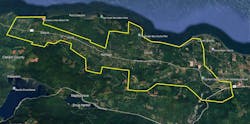Astound Broadband brings broadband to life in Washington’s rural Clallam County
For more reading on Astound’s community partnership approach:
- Astound Broadband's 108-mile Oregon fiber link ushers in a multi-service look
- Astound Broadband continues to pivot to fiber-based broadband
- Astound Broadband is boosting Pierce County, Washington’s broadband capabilities
Washington State’s Clallam County has long been synonymous with being the county that predicts the official presidential election winners, a record it held until 2024.
Now, Clallam County, with an estimated population of 77,550, will soon be recognized as another rural destination for fiber broadband, thanks to its partnership with Astound Broadband.
Clallam County and Astound have formed a partnership to bring broadband fiber internet connectivity to a large, unserved and underserved rural area of the county, which generally extends along and parallel to the approximately 15-mile State Route 112 Highway corridor, beginning just west of Port Angeles.
The project is being administered by the Clallam County Public Works Department, along with its partners, and is the first of its kind undertaken by the county.
When the network is built, it will provide over 1,500 homes with access to Astound’s fiber-to-the-home (FTTH) network, delivering symmetrical speeds of up to 5 Gbps. The FTTH network will leverage Calix’s GPON technology.
Steve Gray, deputy director of Clallam County Public Works, said that the partnership with Astound is a way to get service to areas of the county where connectivity options are nearly non-existent. “Our broadband speeds on the rural West part of the county are pretty low or not available really at all,” he said. “This is a great project to provide that service to our rural areas.”
A hybrid build
Over the next year, Astound will build about 100 miles of fiber, extending its existing fiber network and high-speed services to the community of Joyce, as well as other areas of unincorporated Clallam County.
Astound will deploy fiber using a hybrid method, leveraging both aerial and underground cable settings, which will be determined by the specific nature of the locations the network will serve.
In environmentally sensitive zones and tribal lands, Astound will leverage directional boring to minimize surface disruption. The service provider will also install network access points for managed scalability and node redundancy.
“The infrastructure will be mostly aerial,” said Jared Sonne, senior vice president and general manager, West Region for Astound. “There’s existing pole line infrastructure in a lot of this area, but there will be a portion of this that will be built underground.”
With the network build already underway, Astound expects to complete the network build by the end of 2026.
However, Sonne said that “usually with projects like this, we may be able to start offering service to residents before the full project is complete.”
Astound's fiber network, when complete, will serve four main zones in Clallam County:
- Western portions of Port Angeles and Sequim
- Remote community clusters in Joyce and Carlsborg
- Underserved tribal regions within Lower Elwha Klallam and Jamestown S’Klallam territories
- Unincorporated farming and forested districts along Highway 112
Addressing rural challenges
A key challenge that Clallam County has is that many parts of it are rural. The county’s largest community has about 22,000 people and three key cities in the county.
With a population density averaging around 30 people per square mile, Clallam is classified as predominantly rural.
While Port Angeles, the county seat and largest city with 22,000 residents, is a key area of economic activity, a large number of residents reside in smaller towns or across dispersed communities, including Sequim, Forks, and outlying tribal lands. The lower-density population in the rural cities makes it challenging to upgrade broadband infrastructure.
This deployment marks the first time residents will have access to fiber-based internet, replacing outdated satellite and copper-based systems with gigabit-capable speeds.
Gray said the challenge is in the western part of the county. “As you go westward, it's mostly forest land and rural land, so the densities are low," he said. "Getting high-speed Internet broadband in those areas does require these partnerships because the ISPs can't get the capital to do it themselves, so it's truly a partnership."
In terms of broadband options available in Clallam County, the choices were limited to either slow DSL or satellite service, both of which offer speeds below the FCC’s 25 Mbps definition.
According to one report, in Clallam Bay, the average internet download speeds were not quite 10 Mbps. Making matters worse, the speeds would often drop to under 5 Mbps during peak hours. When the network build is complete, households will be able to access speeds of up to 5 Gbps, providing symmetrical connectivity.
“There was some slow cable service, and I do believe some of the landowners in the area do have satellite, but over a broader area, it's either unserved or underserved with speeds less than 25 Mbps," Gray said.
What has made broadband expansion challenging in Clallam County is the county's mountainous terrain and dense forest canopy. This not only obstructs the line of sight for wireless solutions but also increases the cost of underground fiber deployment. Additionally, low population density inhibits private-sector incentive for building next-generation networks across most of Clallam County.
“This is a unique deployment because it’s an area that does not have wired broadband infrastructure,” Sonne said. “It’s a very rural part of Clallam County, which makes it very expensive to put in infrastructure.”
Today, residents have access to DSL internet service. Depending on the cellular infrastructure, some residents may have access to wireless or satellite service options.
Sonne noted that “usually those options are either costly or are unreliable in terms of delivering connectivity.”
Enabling remote learning, working
Besides offering better service for residents, the new fiber network will be a welcome benefit for local anchor institutions.
Astound and its partners will also prioritize bringing fiber to fire houses, schools, libraries, medical clinics, and other key anchor institutions in the county. "This network will significantly enhance the level of connectivity options for schools and other local anchor institutions,” Sonne said.
Healthcare clinics offering telemedicine—especially those in geographically isolated zones—will operate with greater efficiency and reach. Since travel times to Port Angeles or Sequim can exceed an hour, a stable connection eliminates that barrier, allowing for residents to conduct remote telehealth sessions.
Libraries and schools will also be able to leverage the fiber network to support more digital services. Schools can also expand their online learning capabilities, providing students with uninterrupted remote access to educational resources.
“Our rural area does have several businesses and anchor institutions, such as the schools and healthcare institutions,” Gray said.
He added that the presence of Astound's fiber broadband service will also make Clallam County a potentially attractive destination for remote workers who require broadband connectivity. “A lot of people are working remotely nowadays, so we see this being a benefit to our rural residents,” Gray said.
With this new fiber infrastructure in place, Sonne agreed it will provide those remote opportunities.
“Remote school and work might be risky now if you want to live in that area,” Sonne said. “Once we have the infrastructure in place, it becomes more and more feasible, so it’s a boost to a community.”
Having conducted similar projects in areas such as Tillamook, Oregon, and Pierce County, Washington, Astound has extensive experience serving remote rural areas.
Sonne said the common denominator in all these areas is a desire to get fiber-based broadband.
“What we've found when we build in remote areas like Clallam County, there’s a certain percentage of the residents that are starving for this level of broadband,” he said. They will subscribe as fast as they can, while others will take time to learn about what’s available and why it’s more robust and explore a change.”
Another effect is that it will make the area more attractive to existing and potential new businesses.
“This will do a lot for economic development,” Sonne said. “If the county is looking to expand economic development in this area, this takes away one of the major barriers to that by ensuring that you have top-of-the-line broadband infrastructure.”
The Clallam County and Astound Broadband fiber network is being supported with funding from three key sources:
• $16 million from the Washington State Broadband Office via the American Rescue Project Act (ARPA) State and Local Fiscal Recovery Funds
• $4.5 million from the Washington State Department of Commerce Public Works Board Broadband Program, including grants from the ARPA Coronavirus Capital Projects Fund
• $1.7 million from Clallam County
Diverse funding sources
To fund this project, the county and Astound Broadband developed several funding mechanisms.
A combination of funding sources was put together to support the $22.2 million partnership between Clallam County and Astound.
“The project started with the grant source coming through the two-state grants that we received,” Gray said. “One of the requirements was to have an ISP partner, and Astound was one of them that agreed if we got the grant to be a partner, so that's where the partnership started.”
He added that “once we received the grants and working with our other partner, the Clallam County Public Utility District, we’ve formalized agreements with Astound to manage and operate the system once it's constructed.”
Given the rural nature of Clallam County, the cost of serving the area with 1,500 homes would be too steep for providers like Astound to do on their own.
Sonne said the cost per home would be approximately $15,000. “For most broadband companies like ours to fund this on our own, we’re looking for projects where we would be looking for $1,000 to $1,500 per home max," he said. "This is why no one has built out there previously because the cost was too prohibitive."
If anything, the Astound agreement is another example of a new public-private partnership for broadband.
“Without public-private partnerships, these projects don’t happen,” Sonne said. “The public entities help with project management and facilitate the construction with permitting, and help to secure publicly available funds.”
BEAD readiness
By committing to this project, Astound is helping Clallam County prepare for Broadband Equity, Access, and Deployment (BEAD) Program projects.
As part of the BEAD program, there are projects in the county that extend beyond this project, reaching as far as Forks, Washington.
Astound is applying for several of those grants to build those networks using BEAD funds.
“This project is step one in terms of moving West from Port Angeles to get broadband infrastructure to the remote Northwest part of the state,” Sonne said.
Astound’s project in Clallam County is a precursor and a bridge for other BEAD projects. “For a service provider like Astound, the BEAD dollars that are available in more rural areas beyond this project, we probably would not be pursuing those if it weren’t doing this project,” Sonne said. “This is because it would be cost-prohibitive even when you’re getting 75 percent of federal funds and the applicant has to provide 25 percent.”
However, he added that because “we’re building this project, that makes the other BEAD projects further West become much more feasible and we're in the process of applying for those funds.”
Multi-tier partnership
The Public Utility District No. 1 of Clallam County (PUD) is another key participant in this project.
Clallam County and the PUD entered into an Interlocal Agreement for the PUD and its partner, NoaNet, to provide the county with project grant management and professional services. The PUD also supports the county with project management and coordination with Astound. Utilizing the PUD’s existing infrastructure (e.g., power poles) to support the high-speed fiber construction has contributed to project cost savings.
Astound’s backbone fiber infrastructure is crucial to the project's success, as the effort would otherwise exceed the available grant funding. The service provider has also committed to project-managing the build over the next year, leveraging internal resources to help reduce overall costs.
Once construction is complete, Astound and Clallam County have an agreement for Astound to maintain and operate the fiber optic communications network. The county is in the process of entering into a similar agreement with the PUD regarding joint-use facilities to be constructed under the project along the SR 112 corridor.
Sonne said Astound's relationship with the PUD has multiple elements. “The PUD will ensure there’s an operator of the network that will be built. As part of the construction, there will be quite a few upgrades to the existing infrastructure, including new poles, so there’s a benefit to the PUD in a couple of different ways.”
Gray said the partnership with the PUD has been vital.
“The PUD has done broadband projects before, so they've been crucial for really managing our project, working with Astound,” he said. “Of course, the PUD has infrastructure that can be utilized. Also, they are going to be managing our main fiber line along the highway corridor."
Gray added that while it sees the value of the fiber and broadband network, the county has no interest in being a service provider itself. “We have our fiber strands for maintenance and operations, which was key to get these agreements because the county itself doesn't want to be in the broadband business. But we wanted to be the facilitator of getting this funding and public-private partnership going.”
Regardless of the community Astound is serving, the service provider looks to understand that community’s unique needs best. That all ties in with having local feet on the street, which in Clallam County’s case means a regional hub in Port Angeles.
“We’ll tailor our efforts to the community and what options are available,” Sonne said. “We’ll spend some time and money communicating with residents who we are, we’re local, and the network build will bring jobs, and we'll add staff to support the business in the area.”
For related articles, visit the Broadband Topic Center.
For more information on high-speed transmission systems and suppliers, visit the Lightwave Buyer’s Guide.
To stay abreast of fiber network deployments, subscribe to Lightwave’s Service Providers and Datacom/Data Center newsletters.
About the Author
Sean Buckley
Sean is responsible for establishing and executing the editorial strategy of Lightwave across its website, email newsletters, events, and other information products.



